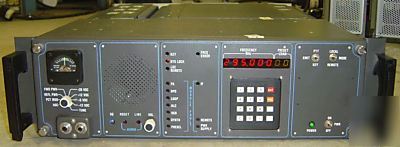____________________ > Aurora
> System components
> Old Style
> Tools
> Hand tools
> Motorola 2225 uhf communications radio/transceiver
Motorola 2225 uhf communications radio/transceiver
Motorola 2225 UHF Communications Radio/Transceiver
Comes with an operations manual, 220 Volt power cord (has both prongs as sideways) and what you see in the pictures. If you don't see it, you probably wont get it.
Specifications are from Motorola and may vary slightly due to upgrades, options or revisions this unit may or may not have.
Unit powers up and if you turn the volume up you can hear fuzzy noise (it isn't connected to anything). Other then that, we have no way to test it.
The Model 2125/2225 VHF/UHF Communications Radio can be used as a transmitter, receiver or transceiver.
Features of the Series 21/22 are summarized as follows:
* Fully-synthesized receiver and transmitter
* Expandable common module structure
* Microprocessor-controlled operation
* 3-microvolt receiver sensitivity
* Preset channel (20) capability with nonvolatile memory
* Module fault indicators built-in
The transceiver is an all solid-state voice communication radio composed of eleven functional modules contained in and attached to a main frame. The transceiver operates in the 225 to 399.975 MHz UHF band. It is tunable across both bands in 25 kHz steps. The Filter/Switch or HPO, Receiver preselect, and Power Amplifier modules are used for one band, UHF or VHF. If the operational frequencies are moved from one band to the other, these modules must be changed. All other modules are used for both bands.
Receive only is an optional configuration of the Series 21/22. For the receive only mode of operation, two of the modules used in the transceiver are not installed in the unit. These are the power amplifier and the ALC modules. Four receiver output circuits are provided; a front panel mounted speaker, an external eight-ohm output connector on the unit rear panel, a 600-ohm balanced line output (handset connector) on the front panel, and a 1 mW audio monitor output on the rear panel.
Transmit only is an optional configuration. In the transmit-only mode of operation, the two receiver modules, Preselector and IF, are not installed. There are two audio inputs to the transmitter; one through a handset connector on the front panel and the other through the remote connector on the rear panel.
Operating power for the transceiver is supplied by a power supply module attached to the rear panel of the main frame. The power supply accepts inputs of 110/220 VAC +/- 20%, 47 to 400 Hz and supplies the dc voltages to the transceiver.
Remote Control (may not have this option):
The Series 21/22 transceiver may be operated from a location up to 100 feet away from the transceiver. A function box is used to provide frequency control, system status indication, microphone (audio and key) input, and audio (speaker) output.
Transceiver Characteristics:
Physically the transceiver is 19 inches (48 cm) wide by 5-1/4 inches (13 cm) high by 23 inches (59 cm) deep and weighs 84 pounds (38 kg).
Transceiver Electrical Characteristics:
Frequency Range: 225 to 399.975 MHz UHF
Number of Channels: 7000 UHF
Preset Channel: 20 channels, addressed via keyboard
BITE: Module indicating BITE
Primary Power: 110/220 V +/- 20%, 47 to 440 Hz
Duty Cycle: Continuous with adequate air flow w/derating, contact factory about airflow requirements
Intermodulation: >60 dB, 3rd order change in f=150 kHz
Cross-modulation: >80 dB change in f=0.5 MHz, >100 dB change in f=7.0 MHz
Selectivity: 22 kHz, 6 dB down - 200 kHz, 60 dB down
Sensitivity: 3.0 V for 10 dB S+N/N (30% AM, 1 kHz modulating signal)
Narrow Band: 300 to 3,000 Hz nominal
Output: 0.3 watt minimum speaker on front panel. 3 watt minimum external 8 ohms speaker 1 mw, 600 ohms monitor audio
AGC: 3 dB output variations for inputs from 3 V to 0.1 V
Transmitter Characteristics:
Power Out (50 ohms): 50 watts CW
Spurious: >50 dB below fundamental for change in f > 1 MHz
Modulation: Up to 90% amplitude modulation (factory normally sets at 70%)
Narrow Band: 300 to 3,000 Hz
Microphone Input: 52 to 520 mV at 600 ohms
Distortion: 10% max at 80% modulation

